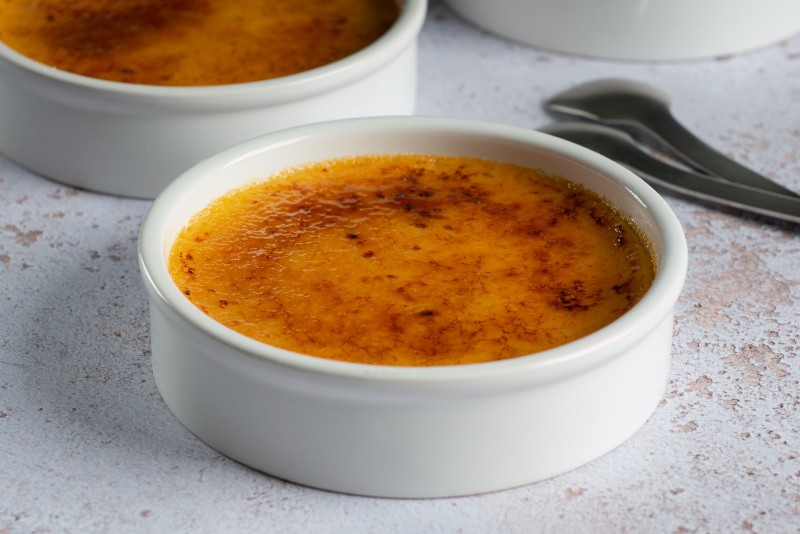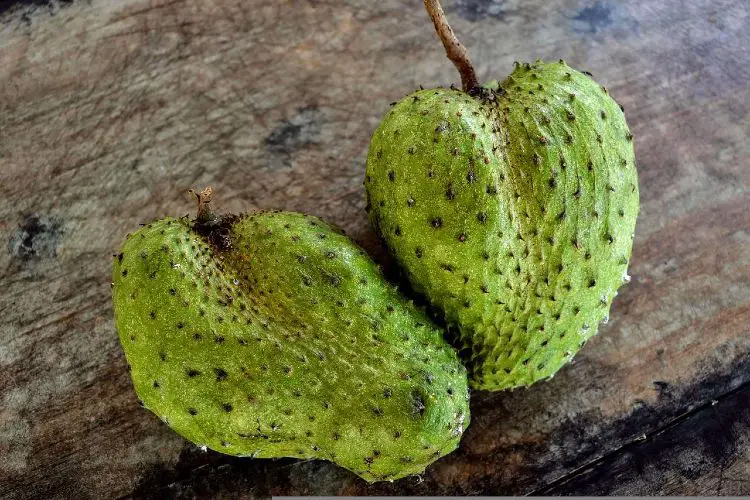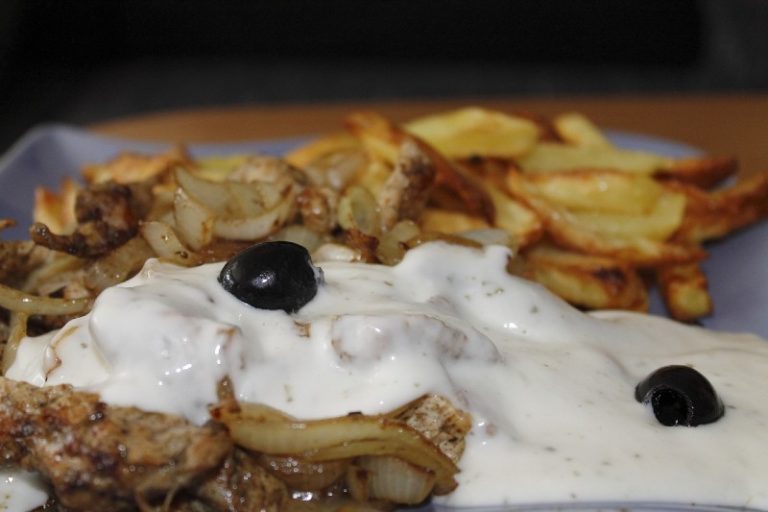What Does Creme Brulee Taste Like?
Quick Answer
Crème brûlée has a silky, smooth custard base with a rich, vanilla-infused flavor that’s sweet but not overly so. On top, there’s a hard, caramelized sugar layer that’s brittle and adds a toasty, slightly burnt taste. The combination of the creamy custard and the crisp sugar crust offers a delightful contrast in both texture and flavor.
What is Creme Brulee?
Crème brulee, which translates to “burnt cream” in French, is a classic dessert originating from France. It consists of a rich, creamy custard base made primarily from heavy cream, egg yolks, and sugar, usually flavored with vanilla.
The custard is cooked in a water bath to achieve its characteristic silky texture. After cooling, a layer of granulated sugar is sprinkled over the surface and then caramelized using a kitchen torch or a broiler, forming a hard, brittle crust.
The end result is a dessert with a smooth, creamy interior and a contrasting crisp, caramelized sugar top.
creme brulee is often served in individual ramekins and can be enjoyed either slightly chilled or at room temperature.
It’s known for the satisfying “crack” sound the sugar crust makes when tapped with a spoon, revealing the soft custard underneath.
The dessert is commonly flavored with vanilla, but variations may include other flavors like coffee, citrus, or even savory spices.
What Does Creme Brulee Taste Like?
Custard
The custard base of creme brulee typically bursts with rich, creamy flavors that come from its key ingredients: heavy cream and egg yolks. It is sweetened to a point where it’s satisfying but not overwhelming.
Vanilla is the signature note in the classic crème brûlée, often derived from natural vanilla beans, extract, or paste.
These vanilla undertones add a floral, slightly woody complexity to the custard, elevating its creamy richness into something truly special.
The result is a harmonious blend of sweetness, richness, and aromatic subtlety.
Sugar Crust
The sugar crust on creme brulee is more than just a sweet layer; it’s a textural and flavorful contrast to the creamy custard below.
When the granulated sugar is caramelized using a kitchen torch or broiler, it transforms into a brittle, glass-like layer with a complex flavor profile.
This process introduces toasty, and slightly burnt nuances that add depth and complexity to the dessert. The caramelized sugar is not just sweet; it has a slight bitterness that complements the custard’s sweetness perfectly.
Together, the sugar crust and the custard create a balanced and delightful taste experience.
What is The Texture of Creme Brulee Like?
Custard
The custard in creme brulee is a study in culinary silkiness. The texture is exceptionally smooth, almost velvety, owing to the rich ingredients like heavy cream and egg yolks.
These elements emulsify into a homogeneous blend, offering a melt-in-your-mouth experience that is luxuriously soft. Cooking the custard in a water bath helps to maintain its delicate texture, making it creamy without any hint of graininess. The result is a custard that is so smooth, it almost feels like eating a cloud.
Sugar Crust
In sharp contrast to the custard’s creaminess stands the sugar crust – crisp, brittle, and wonderfully hard. The caramelized sugar layer is achieved by sprinkling granulated sugar over the cooled custard and then using a kitchen torch or a broiler to heat it until it melts and subsequently hardens into a glass-like crust.
This provides a delightful textural counterpoint to the custard, creating an audible “crack” when broken with a spoon.
The sugar crust’s brittle nature offers not just a different texture but also an interactive eating experience, adding an element of fun as you break through the hard layer to reach the soft custard below.
The Sensory Experience
The magic of crème brûlée lies in its harmonious blend of contrasting flavors and textures, creating a multi-layered sensory experience.
The creamy, rich, and subtly vanilla-flavored custard offers a taste of indulgence, which is perfectly balanced by the toasty, slightly bitter undertones of the caramelized sugar crust.
The textures add another level of complexity: the silky-smooth custard provides a lush mouthfeel, while the brittle sugar crust gives a satisfying crunch. Together, they deliver an intricate play of creamy and crispy, sweet and slightly bitter, that makes each bite a delightful surprise.
Common variations in flavors include additions like citrus zest, coffee, chocolate, or even spices like cinnamon or cardamom, each bringing its own nuance to the classic vanilla base.
Texturally, some chefs experiment by adding elements like fruit compotes at the bottom or incorporating nuts into the sugar crust for an extra crunch.
These variations offer a new perspective on the classic dessert, showcasing its versatility while maintaining the essential interplay of flavor and texture that makes creme brulee so universally loved.
Difference Between Crème Brûlée and Crème Catalana
Both crème brûlée and crème Catalana are creamy, custard-based desserts, but they hail from different culinary traditions and have their own unique features:
- Crème Brûlée: A French dessert, crème brûlée is generally made with heavy cream, egg yolks, sugar, and vanilla. The custard is cooked in a water bath and finished with a hard, caramelized sugar crust.
- Crème Catalana: Originating from Catalonia in Spain, this dessert is lighter and often flavored with citrus zest and cinnamon. Instead of heavy cream, milk is commonly used. The sugar topping is also caramelized, but it is generally softer than the hard sugar crust of crème brûlée.
In summary, crème brûlée is a French dish that is heavier and often vanilla-flavored, while crème Catalana is a Spanish dessert that is lighter, flavored with citrus and spices, and features a softer caramelized sugar topping.
FAQs
Is Crème Brûlée Very Sweet?
Crème brûlée is sweet but not overwhelmingly so. The creaminess of the custard and the slightly bitter notes from the caramelized sugar create a balanced flavor profile.
Can Crème Brûlée Have Different Flavors?
Yes, while vanilla is the traditional flavor, variations include chocolate, coffee, fruit-infused versions like raspberry or lemon, and even spices like cinnamon or cardamom.
Does The Caramelized Sugar Taste Burnt?
The caramelized sugar has a toasty flavor with slight burnt notes, but it shouldn’t taste acrid or overly burnt. The bitterness complements the sweet custard.
Is The Sugar Crust Hard Or Soft?
The sugar crust is hard and brittle, offering a crunchy texture that contrasts the smooth custard. It should “crack” when you tap it with a spoon.
What Is The Texture Of The Custard Like?
The custard is smooth and silky, often described as melt-in-your-mouth. It offers a velvety mouthfeel that contrasts the brittle sugar crust.
How Does The Serving Temperature Affect The Taste?
Crème brûlée can be served slightly chilled or at room temperature. The flavors may be more pronounced at room temperature, but the contrast in texture is more evident when it’s chilled.
Does Crème Brûlée Taste Eggy?
The egg yolks do contribute to the custard’s richness, but a well-made crème brûlée should not have an overpowering eggy taste. The vanilla and sugar usually mask any strong egg flavor.
Can I Make A Dairy-Free Version of Creme Brulee? Will It Taste Different?
Yes, you can make a dairy-free version using alternatives like coconut cream. The texture and flavor will be slightly different but still enjoyable.
Can I Use Artificial Sweeteners for Creme Brulee?
You can, but it may affect the taste and the ability to create the caramelized sugar crust. Some sweeteners do not caramelize the same way sugar does.
Is Crème Brûlée the Same as Flan?
While crème brûlée and flan may seem similar due to their creamy textures and custard bases, they are distinct desserts with unique characteristics:
- Crème Brûlée: Originating from France, crème brûlée is a rich, vanilla-flavored custard with a hard, caramelized sugar crust on top. It’s typically made with heavy cream, egg yolks, sugar, and vanilla, and is cooked in a water bath.
- Flan: Also known as crème caramel, flan is a Latin and Spanish dessert that is lighter and less rich than crème brûlée. It is made with milk, sugar, and eggs and flavored with vanilla. Flan is often cooked with a liquid caramel at the bottom, which becomes a syrupy sauce when inverted onto a plate.
The primary differences lie in the ingredients, texture, and presentation. Flan is lighter and often served with a caramel sauce, while crème brûlée is richer and characterized by its hard sugar crust.
What Does Crème Brûlée Coffee Taste Like?
Crème brûlée coffee is a flavored coffee variant that aims to capture the essence of the classic dessert. This coffee usually combines the rich, full-bodied taste of coffee with the creamy, vanilla undertones of crème brûlée. Some variations even offer hints of caramel, mimicking the dessert’s caramelized sugar crust. Overall, crème brûlée coffee provides a harmonious blend of bitterness and sweetness, offering a unique and indulgent drinking experience that is both aromatic and flavorful.
What Does White Chocolate Crème Brûlée Taste Like?
White chocolate crème brûlée incorporates white chocolate into the traditional custard base, resulting in an even creamier and sweeter profile. The white chocolate adds a buttery richness, along with a cocoa butter aroma that harmonizes with the vanilla notes. The sugar crust remains crispy and slightly bitter, providing the necessary contrast to balance the sweetness of the white chocolate. If you enjoy white chocolate, this variation adds an extra layer of indulgence to the classic crème brûlée experience.



